Black Barbering in Mattoon
A Snip of Life:
Black Barbering in Nineteenth Century Mattoon
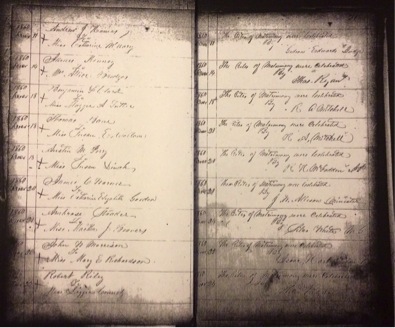
Page 218 from Coles County Book of Marriage Records, Volume B, Illinois Regional Archives Depository at Eastern Illinois University
This page from the Coles County Book of Marriage Records, Volume B lists the marriage of Austin Perry, Mattoon’s first barber, to Susan Linch on December 18, 1860. Although both Mr. and Mrs. Perry were mulatto, as indicated by the 1870 United States Federal Census, their marriage record does not indicate their racial status. This may be an accident of poor record keeping, as counties did not always keep accurate records in the nineteenth century. It is also possible that in the case of marriage, their race did not matter. Susan Linch may have been the stepdaughter of John Powell, another early Mattoon barber; a 1902 article in the Mattoon Gazette indicates, incorrectly, that he married Susan Powell in 1860 and another article from 1860 mentions that John Powell’s stepdaughter was talking with Austin Perry when Powell drunkenly assaulted her.
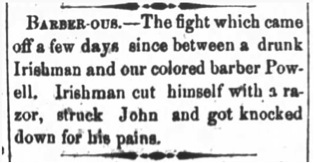
“Barber-ous,” Mattoon Gazette, 17 April 1862, Newspapers.com.
In this article, John Powell is referred to as “our colored barber.” The use of the term colored suggests that his color should be noted and was considered significant. This term was used quite commonly in Mattoon newspapers in the nineteenth century to denote black barbers and it indicates that these men were perceived as different and characterized by their color despite the fact that there were no white barbers at the time.
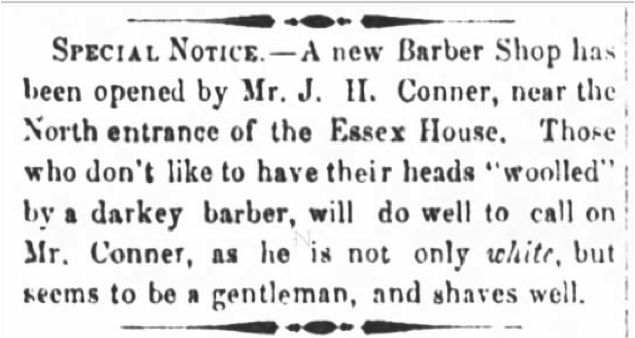
"Special Notice,” Mattoon Gazette, 28 February 1863, Newspapers.com.
This image is of a special notice in the Mattoon Gazette from February 28, 1863. It notes the opening of a white barbershop in Mattoon. The order of description suggests that his whiteness was his most important attribute, while his ability to shave was the least significant quality in his barbershop. Combined with the description of the black barbers as “darkey,” and the general tone of the notice when describing them, this indicates a deeply ingrained prejudice. However, other articles, which will be described later, speak highly of the town’s black barbers.
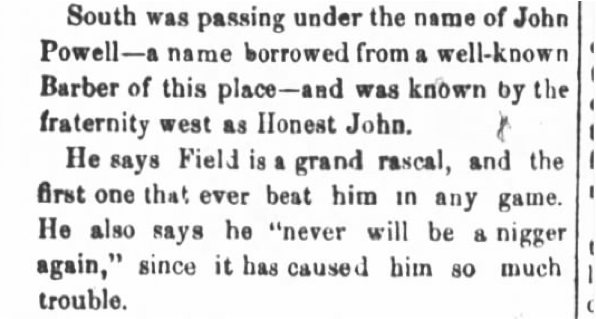
Clipping from “Arrest of Jake South,” Mattoon Gazette, 11 May 1864, Newspapers.com.
This article details the re-arrest of escaped murderer Jake South who was using the identity of the Mattoon barber, John Powell who is mentioned in the article above from April 1862. It states that Powell is known in the west as Honest John, at least by reputation. The article suggests that this is the reason South was using Powell’s identity. This indicates that this barber and his reputation were well known outside his immediate area, probably due to the presence of the railroad. Powell was so well respected that a known murderer co-opted his identity to hide.

Clip from “City in Brief,” Mattoon Gazette, 22 October 1875, Newspapers.com.
This cliping states that New York barbers have decreased their prices by five cents a shave and suggests that the Mattoon barbers should do the same. This indicates that the barbers in Mattoon charged more than five cents per shave and that the people of Mattoon would prefer to pay less for their services. The language used, calling barbers “chin-scrapers,” suggests a certain amount of disdain for the barbers of Mattoon, who were mainly black at this time. This could be because they are part of the service industry, but could also be due to their race and prejudices held against them.
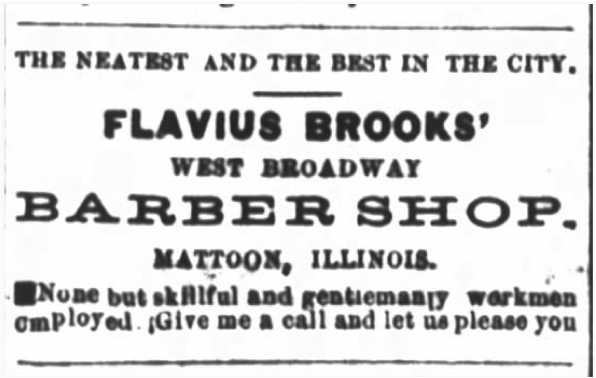
Advertisement for Flavius Brooks’ Barber Shop, Mattoon Gazette, 24 December 1880, Newspapers.com.
This advertisment for the baber shop of Flavius Brooks is somewhat obseqious, using language such as “let us please you.” This suggests a certain amount of service was expected of barbers in Mattoon in the nineteenth century in order to obtain success. Brooks was successful, as will be seen in the next clipping. He also states that his employees are all “skillful and gentlemanly,” impying that this was an essential part of running a profitable shop. The order of this discription suggests that the skill of his workmen was the most important aspect of a barbershop to Mr. Brooks.
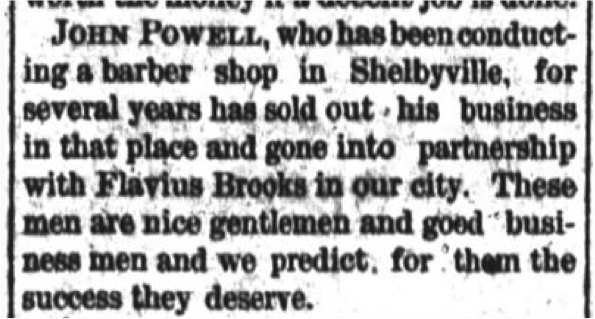
Clipping from “The City in Brief,” Mattoon Gazette, 25 November 1881, Newspapers.com.
The language in this clipping indicates that John Powell (likely the son of John Powell and the first black child born in Mattoon) and Flavius Brooks were well regarded within their community and that the town clearly wanted them to succeed. However, this article is unusual in that it does not offer the racial status of the two barbers, information that was obtained from the Directory of Coles County and the City of Mattoon.: 1895-96. As seen above, a racial description was generally included in articles about Mattoon’s black barbers. It is not clear why race was not included here, but it is certain that Powell and Brooks were well regarded in Mattoon.
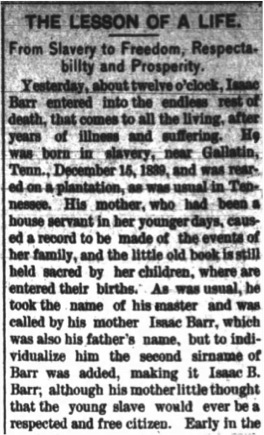
Clipping from “The Lesson of A Life.,” Isaac Barr’s Obituary, Mattoon Gazette, 3 February 1882, Newspapers.com.
This clipping from the 1882 obituary of respected barber Isaac Barr is an indication of how far a black man could come as a barber. This clipping was found in the Mattoon Gazette from February 3, 1883. Barr was born a slave in 1839, but by the time of his death had become a well respected and prosperous barber. He had enough status in the community to require an entire column of the newspaper for his obituary, only part of which has been reproduced in this image and the one below. This section states that his name came from that of his master, which is noted to be common. The later detailing of his early life as a slave provides a view into what may have been the origins of many black barbers, although he did not join the profession as a slave, nor was it the cause of Barr gaining his freedom. The next clipping details Barr’s journey into his chosen career. Entire article found at https://www.newspapers.com/clip/3752981/mattoon_gazette/.
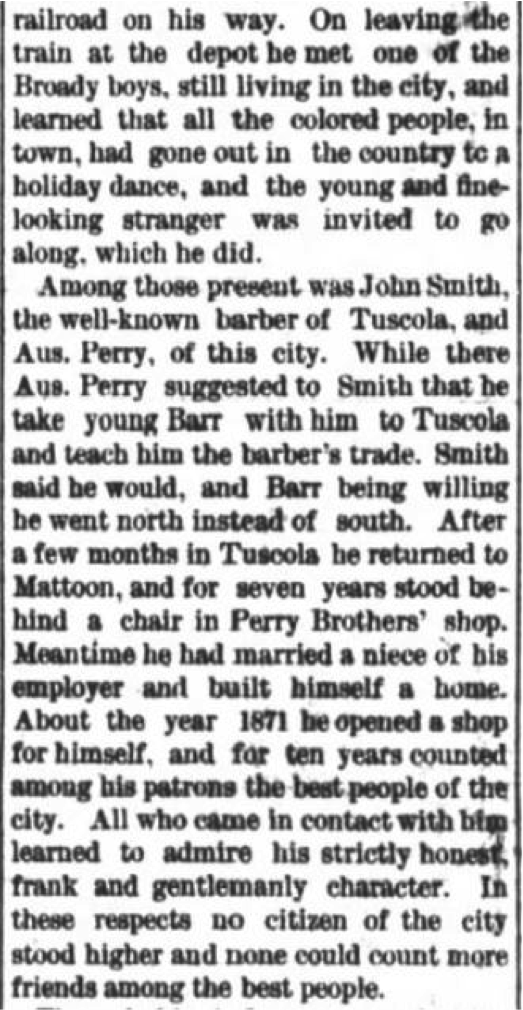
Clipping from “The Lesson of A Life.,” Isaac Barr’s Obituary, Mattoon Gazette, 3 February 1882, Newspapers.com.
This clipping describes how Isaac Barr joined the barbering profession. On his return from Brazil he was set to change trains in Mattoon. When he left the station he was invited to a holiday party in the country, which was specifically for the colored people of the town. There he met Austin Perry and John Smith, a Tuscola barber, who took him under their wing, sending him to be trained in Tuscola before returning to work for Perry in Mattoon. He later married Perry’s niece and opened his own shop in 1871, which he ran for ten years. The article specifies that his customers included the best people in the city, suggesting that he was both a very good barber and well liked.
The specifically colored holiday dance suggests that although many of the black people, particularly the barbers, in Mattoon were well respected, they were still considered different, requiring them to hold their own parties. It is also revealing of the personalities of both Austin Perry and John Smith in that they took a young man, whom they had never met and trained him in a very lucrative, and likely quite competitive, career.

"Abbreviations.” Directory of Coles County and the City of Mattoon.: 1895-96, housed at the Charleston Public Library.
This image from the Mattoon City Directory, 1895, shows a list of abbreviations used within the directory. It denotes col’d, for colored, as one of the abbreviations, indicating that every person of color was noted as such. This may have been for reasons of clarity and thoroughness, but it was most likely so that people knew who was colored and who was not so that they could avoid using colored businesses if they wished. It indicates an internalized prejudice that, while it may not have been intentional, was still pervasive among the citizens of Mattoon in the 1890
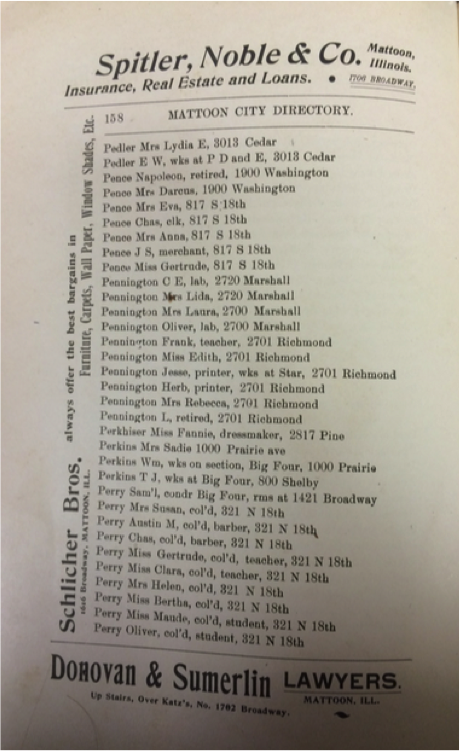
Mattoon City Directory 1898, page 158, housed at the Mattoon Public Library.
This is an image of a listing in the 1898 Mattoon City Directory. It shows the listing and address of the first Mattoon barber, Austin Perry. Although well known and respected, having served as alderman of the town council for two terms in 1880, Perry is listed as col’d. This suggests that no matter how well liked and successful a black man or woman was, they were still black and had to be considered as such. Once again, this reveals a deep seeded prejudice that was always under the surface, regardless of the individual’s position.
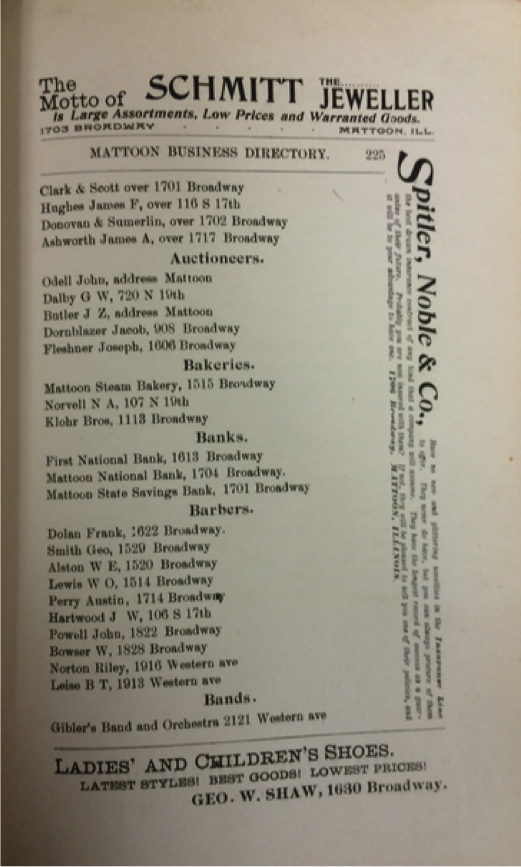
Mattoon Business Directory in the Mattoon City Directory 1898, page 225, housed at the Mattoon Public Library.
This image is also from the 1898 Mattoon City Directory, listing the barbershops in Mattoon. Of the ten barbershops listed, three were owned by white men, one was owned by a man of unknown racial status, as he is not listed in the city directory at all, and the remaining six were owned by black men, one of whom was the first barber in the city, Austin Perry. It is evident that barbering was still a position mainly held by black men, even though the number of white barbers and black barbers was even in 1898. In addition, none of the men are labeled as colored in this section of the directory even though they are listed as colored at their personal address. This suggests either that their race was common knowledge and it was unnecessary to label the shops or that people were expected to check for themselves within the rest of the directory. It is also possible that it did not matter in this situation because barbering was traditionally black, even though there had been white barbers on and off in Mattoon since 1863.
Bibliography
Images
“BARBER-OUS.” Mattoon Gazette, April 17, 1862. Accessed December 2, 2015. Newspapers.com. https://www.newspapers.com/clip/3753094/barberous_mattoon_gazette_17_apr/
“City in Brief.” Mattoon Gazette, October 22, 1875. Accessed December 3, 2015. Newspapers.com. https://www.newspapers.com/clip/3753088/city_in_brief_ mattoon_gazette_15_oct/.
“Flavius Brooks’ West Broadway Barber Shop.” Mattoon Gazette, December 24, 1880. Accessed December 1, 2015. Newspapers.com. https://www.newspapers.com/clip/3753026/flavius_brooks_shop_mattoon_gazette/.
“Local Items: Arrest of Jake South.” Mattoon Gazette, May 11, 1864. Accessed December 1, 2015. Newspapers.com. https://www.newspapers.com/clip/3753079/local_items _arrest_of_jake_south/.
“Local Items: Special Notice.” Mattoon Gazette, February 28, 1863. Accessed December 1, 2015. Newspapers.com. https://www.newspapers.com/clip/3753103/local_items_special_notice_mattoon/.
Marriage record of Austin Perry and Susan Linch. Dated December 18, 1860. Mattoon, Illinois. Coles County Book of Marriage Records, Volume B: 218. Illinois Regional Archives Depository, Charleston, Illinois.
Sumerlin, A. compiler. Directory of Coles County and the City of Mattoon: 1895-6: Comprising a List of Residents, Business, Houses, Churches, Societys, and Miscellaneous Directory. Mattoon, IL: Mattoon Commercial Print, 1895.
Sumerlin, A. compiler. Mattoon City Directory 1898. Mattoon, IL: Mattoon Commercial Print, 1898.
“The City in Brief.” Mattoon Gazette, November 25, 1881. Accessed December 3, 2015. Newspapers.com. https://www.newspapers.com/clip/3752977/the_city_in-brief _mattoon_gazette_25/.
“The Lesson of A Life.: From Slavery to Freedom, Respectability and Prosperity.” Mattoon Gazette, February 3, 1882. Accessed December 2, 2015. Newspapers.com. https://www.newspapers.com/clip/3752981/mattoon_gazette/.
Reference
“Early Days in Mattoon.” The Mattoon Daily Journal Gazette and Commercial Star, April 27, 1927. Accessed December 4, 2015. Newspapers.com. https://www.newspapers.com/clip/3819586/early_days_in_mattoon_journal_gazette/. Illinois. Coles County. 1900 U.S. Census, population schedule. Digital images. Ancestry.com. October 24, 2015. http://ancestry.com.
“Just Two of the Business Men of Old Times Still on Broadway. Tell of Changes That Have Occurred in Mattoon Since its Infancy—Interesting,” Mattoon Daily Journal, July 26, 1902. Accessed December 1, 2015. Newspapers.com. https://www.newspapers.com /clip/3752947/mattoon_daily_journal/.
Mills, Quincy T. Cutting Along the Color Line: Black Barbers and Barber Shops in America. Philadelphia: University of Pennsylvania Press, 2013.
Ogbomo, Onaiwu W. Photographic Images & the History of African Americans in Coles County, Illinois. Charleston, IL: Eastern Illinois University, 2002.








